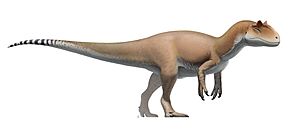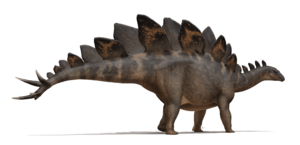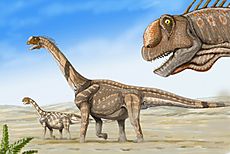Paleontology in Colorado facts for kids

Paleontology in Colorado is all about finding and studying fossils in the U.S. state of Colorado. It also includes research done by people from Colorado.
Colorado's rocks tell a story that goes back about one-third of Earth's history. You can find fossils almost everywhere in the state. However, they are not spread out evenly across all rock ages.
During the early Paleozoic Era, Colorado was covered by a warm, shallow sea. This sea was home to creatures like brachiopods, conodonts, jawless fish (called ostracoderms), sharks, and trilobites. This sea disappeared for a while between the Silurian Period and early Devonian Period. This left a gap in the local rock record.
The sea returned during the Carboniferous Period. Areas not underwater were full of plants and amphibians. These amphibians left behind footprints that later turned into fossils. During the Permian Period, the sea left again. Alluvial fans and sand dunes spread across the state. Many trace fossils (like tracks) are found from this time.
The sea came back during the Triassic Period. Land areas were rich coastal plains with many plants and dinosaurs. Colorado was again covered by a sea during the Cretaceous Period. This sea had huge plesiosaurs that could be up to 70 feet long.
In the early Cenozoic Era, rainforests grew in Colorado. Later, many plants and animals were preserved at the Florissant Fossil Beds National Monument. Here, both rhinoceroses and uintatheres lived. More recently, the state's modern prairies began to form. Creatures like bison, camels, horses, and mammoths lived here.
Local Native Americans created myths to explain fossil bones and dinosaur footprints. By the late 1800s, Colorado's fossils caught the eye of scientists. Important finds include Late Jurassic dinosaurs from the Morrison Formation. Also, Cenozoic plants and mammals from the Florissant beds are famous. The Jurassic plated dinosaur Stegosaurus armatus is Colorado's state fossil. Stegosaurus is also the state dinosaur of Colorado.
Contents
Ancient Life in Colorado
No fossils from the Precambrian Period are known in Colorado. So, the state's fossil record starts in the Paleozoic Era. At the beginning of the Paleozoic, Colorado was near the equator. A warm, shallow sea covered the state.
During the Middle Ordovician Period, parts of Colorado were covered by shallow water. At this time, Colorado was home to many sea creatures. These included brachiopods, conodonts, gastropods (snails), ostracods, pelecypods (clams), sponges, trilobites, and worms. Armored jawless fish called ostracoderms also lived here.
The sea left Colorado sometime between the Silurian Period and early Devonian Period. While the sea was gone, old sediments wore away instead of new ones forming. During the Carboniferous Period, the sea returned. However, some parts of the state stayed dry land. Brachiopods, crinoids, sharks, and trilobites lived in the sea.
Many different plants grew on Colorado's dry land. Examples include Calamites, conifers, and lycopods. Mountain ranges were also forming in western Colorado. During the Carboniferous, early tetrapods (four-legged animals) left footprints that later became fossils. However, Colorado is not a great place to find Carboniferous fossils.
Western Colorado had many alluvial fans during the Permian Period. These were formed when the Cutler Group sediments were laid down. Tracks called Limnopus cutlerensis are found here. These might have been made by a temnospodyl amphibian. The sea left Colorado again during the Permian. In its place were large sand dunes. Tracks from ancient insects and reptiles were preserved in these dunes. Like the Carboniferous, Permian fossils are not as common in Colorado as in states like Kansas or Texas.


Seawater came back to Colorado during the Triassic Period. But large areas of the state remained dry. These land areas had coastal plains with conifers. They were home to creatures like amphibians and dinosaurs. The Late Triassic also saw many footprints form that later became fossils. These are found in the Chinle Formation in northwestern Colorado. A small theropod dinosaur (chicken to turkey sized) left footprints called Agialopous. These rocks also have many Rhynchosauroides tracks, which look like lizard footprints. The Chinle of Colorado also has the most Gwynnedichnium tracks known. Both Triassic amphibians and reptiles left footprints near what is now the Fall Creek Post Office.
During the Late Jurassic Period, when the Morrison Formation sediments were laid down, both sauropods (long-necked dinosaurs) and theropods (meat-eating dinosaurs) left footprints. Only two large fossil footprint sites are known from the Morrison Formation, and both are in Colorado. One site, Rancho del Rio, has both sauropod and theropod tracks. It is located along the Colorado River in central Colorado. The other large site is the Purgatoire Valley tracksite, near the Purgatoire River in southeastern Colorado. The Purgatoire Valley site is 400 meters wide and has four layers with tracks. One layer has over 1,300 individual prints. A series of five parallel trackways made by young sauropods gives important clues about how dinosaurs lived together. These young sauropod tracks help fill gaps in the fossil record. Most sauropod bones from the Morrison Formation are from adult dinosaurs.
Much of Colorado was covered by an expanding sea during the Cretaceous Period. This sea is called the Western Interior Seaway. Algae, fish, molluscs, and marine reptiles lived in its waters. The mosasaur Platecarpus was one such marine reptile. When the Graneros Shale was forming in Colorado, the plesiosaur Thalassomedon lived in the state. This was a very large plesiosaur, over 45 feet long. Beyond the sea's shores were forests and swamps where early flowering plants grew.
Later in the Cretaceous, the sea pulled back. Dinosaurs were still around, but the plants had changed a lot. The forests now had broadleaf trees and palms. At this time, the local Rocky Mountains began to rise. During the Cretaceous, cephalopods with coiled shells and clams were preserved at Monument Creek. Fish scales were also preserved in Colorado's waters. On land, plant leaves also turned into fossils.
The Benton Formation sediments preserved both invertebrates and marine reptiles. The bivalve Ostrea congesta was preserved in the Colorado Niobrara Formation. The Niobrara's animal life included sharks, which left behind fossil teeth. Colorado was home to bivalves and straight-shelled cephalopods when the Pierre shale was forming. These shales formed mound-shaped bioherms up to 15 inches wide. A 60 to 70-foot plesiosaur was found in what is now Baca County, in the southeastern part of the state. Marine mollusks were preserved in the Fox Hills Formation. Oysters and other mollusks were found in the Dakota Formation sediments. Plants from this time were also preserved. The most common plant fossils from the Dakota are the leaves of deciduous trees. Other plants included ferns and palms.
The Rocky Mountains continued to rise into the early Cenozoic Era. They were surrounded by rainforests at this time. Lower areas in the state became huge lakes. Fish, insects, and leaves were buried in the sediments from these lakes. After the Cenozoic began, early Paleocene Epoch turtles left fossils near modern Golden.
Colorado's plants during the Eocene Epoch left behind fossils like ferns, palm leaves, and petrified wood. Animals in northwestern Colorado during the Eocene included the early horse Eohippus, early titanotheres, and uintatheres. Many different plants grew in Colorado during the Oligocene Epoch. At least 150 different kinds of plants from this time are preserved at the Florissant Fossil Beds National Monument. Among these were sequoia trees with trunks up to 17 and a half feet wide. More than a thousand different kinds of insects have been found in these same beds. Beetles were common among the Florissant insects.
Many different mammals lived in this ancient forest. These included animals that looked like giant pigs, rhinoceroses, and titanotheres. During the Pliocene Epoch, Colorado was home to rhinoceroses and giant pig-like animals. The state's modern prairies formed during the Quaternary Period. Colorado also experienced volcanic eruptions. The state's climate slowly got colder as the Cenozoic continued. The rainforests changed into sequoia forests and grasslands. Pleistocene Epoch Colorado had many different mammals. Among them were Archidiskodon, a relative of modern elephants. Bison, camels, horses, and mammoths also lived in the state at this time.
Discovering Colorado's Past
Early Scientific Research
Around March 1877, a man named Oramel Lucas found sauropod bones. This was in a valley called Garden Park, a few miles north of Cañon City. He wrote to Edward Drinker Cope and O. C. Marsh. These were two famous rival paleontologists during the Bone Wars. Marsh did not reply, but Cope did. Oramel Lucas and his brother Ira started digging up fossils and sending them to Cope. These turned out to be from a new species.
By August of that year, Cope officially named the animal Camarasaurus supremus. This species might have been the heaviest known in the entire Morrison Formation. It is estimated to have weighed over 100,000 pounds. Later, a team working for O. C. Marsh, led by Mudge and Williston, started a quarry nearby. They made important finds like the new species Allosaurus fragilis and Diplodocus longus. After these first digs, field work stopped until 1883. That year, brothers Marshall and Henry Felch reopened the digs for O. C. Marsh. They worked for five years, finding many known dinosaurs. They also found the new species Ceratosaurus nasicornis.
In 1890, paleontologist Charles D. Walcott found broken pieces of bony plates. These were from the skin of Middle Ordovician jawless fish called ostracoderms. These fossils were the oldest known vertebrate remains in the world at that time. The rocks holding these fossils were gray and reddish sandstone. They were laid down by shallow water. Other fossils found with the ostracoderms included brachiopods, conodonts, gastropods, ostracods, pelecypods, sponges, trilobites, and trace fossils from worms.
After the Felch brothers finished their work, the Marsh-Felch quarry was not used for twelve years. However, in 1900, William Utterback began working there. He was working for John Bell Hatcher and the Carnegie Museum of Natural History. In the next two years, Utterback found many skeletons of known dinosaurs. He also found the new genus Haplocanthosaurus. This was the smallest known sauropod species from the Morrison Formation.
Around 1920, major fossil finds happened in Oligocene Epoch deposits. Colorado shares these deposits with South Dakota. Dozens of complete skeletons and skulls were found. These included animals like giant peccaries and rhinoceroses. Also found were entelodonts and brontotheriids. A notable rhinoceros discovery happened in Weld County. In 1925, small duck-billed dinosaurs were found in eastern Colorado. Later, in 1955, the American Museum of Natural History found a stone block in south-central Colorado. It held several Eocene Epoch Eohippus skeletons.

In 1960, Malcolm McKenna found two early Paleocene Epoch turtles. He was working for the American Museum of Natural History on South Table Mountain. The next year, the curator of the University of Colorado Museum at Boulder found even more turtles from that time at the same place.
In the summer of 1961, a big discovery happened south of Denver. This was in Douglas County, at a place called Lamb Spring. Charles Lamb, who owned land for cattle grazing, was digging out a watering hole for his cattle. He found many bones under a thin layer of mud. The owners told paleontologists in Denver about the find. The Denver researchers then told the Smithsonian Institution in Washington D.C.. The National Science Foundation then funded an expedition to the watering hole.
The lowest bones found were from Columbian mammoths. Higher up, diggers found bison, camels, and horses. By the end of the summer, 13 huge cases with 341 fossil bones were sent to the National Museum in Washington D.C. The site is now protected as the Lamb Spring Archaeological Preserve. In the spring of 1963, road work in Limon County near the town of Limon uncovered a mammoth tooth and tusk.
In 1965, the Florissant fossil beds were suggested as a possible federal preserve. Peter Robinson studied Miocene Epoch fossil vertebrates in Middle Park in the mid-1960s. These fossils were found northwest of Denver. By 1964, he had found the skull of a fairly large camel. Another important discovery during his research was the seventh known microfauna (small animal fossils) site in the park. More recently, in 1982, the Jurassic plated dinosaur Stegosaurus armatus was named the Colorado state fossil. Stegosaurus was also named the Colorado state dinosaur that same year.
Protected Areas for Fossils
Famous Paleontologists from Colorado
Born in Colorado
- Elaine Anderson was born in Salida on January 8, 1936. She was known for her book, The Pleistocene Mammals of North America. She also researched Ice Age carnivores.
- Myra Keen was born in Colorado Springs in 1905. She became one of the world's top experts on fossil mollusks.
Died in Colorado
- Elaine Anderson died in Denver on March 26, 2002, at age 66.
- Malcolm McKenna died in Boulder on March 3, 2008. He was best known for his detailed classification of mammals.
- Charles Repenning died in Lakewood on January 5, 2005. He was known for his research on fossil desmostylians and shrews.
Museums to Visit
- Denver Museum of Nature and Science, Denver
- Morrison Natural History Museum, Morrison
- Museum of Western Colorado's Dinosaur Journey Museum, Fruita
- Northwest Colorado Field Museum at Colorado Northwestern Community College, Craig
- Royal Gorge Regional Museum & History Center, Cañon City
- University of Colorado Museum of Natural History, Boulder
Clubs and Groups for Fossil Fans
- Western Interior Paleontological Society
- Denver Gem & Mineral Show


